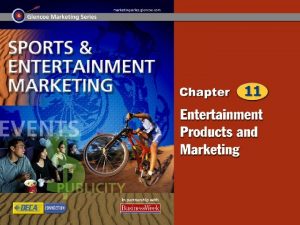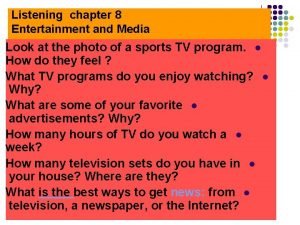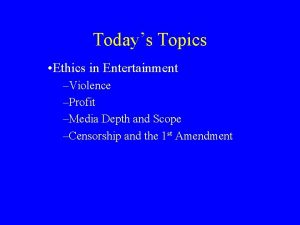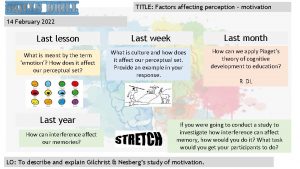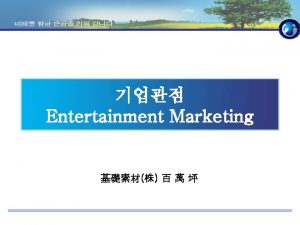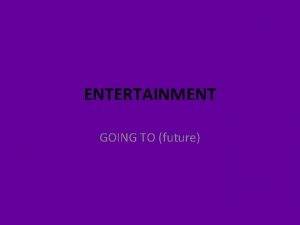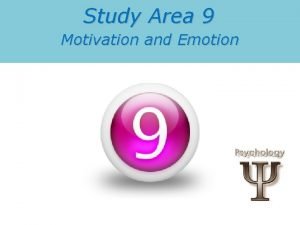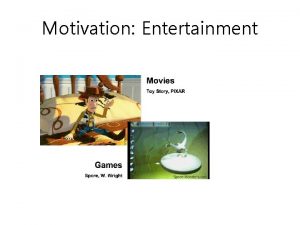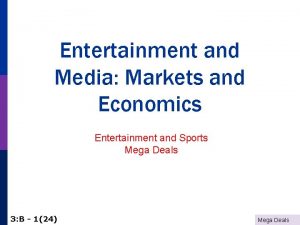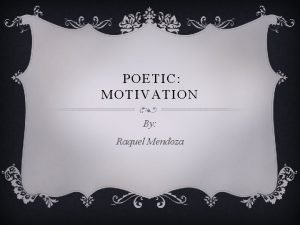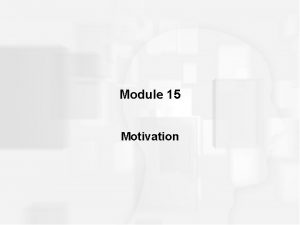Entertainment The main motivation Study of media entertainment
















- Slides: 16

Entertainment The main motivation

Study of media entertainment • Only in the last 15 years or so has entertainment as a media experience received much academic attention – Zillmann’s work in the 1990 s and 2000 s is the main source of knowledge

What is entertainment? • The general idea is that entertainment relates to intrinsic satisfaction of media exposure – Enjoyment of some sort • May be affective (liking) • May be cognitive (gain pleasure from learning, fantasizing, etc. )

Enjoyment • The main idea here is that some form of positive feeling is generated by exposure to media content – Even in the case of negative content, release from the negative feelings through a happy ending is considered a source of enjoyment

What is enjoyable? • “Transportation into narrative worlds” • (Green, Brock & Kaufman) – Loss of attention to the here and now concurrent with an increase in the feeling that one is in another place and time – Transportation is a desired state • Disappointment when audience member just “couldn’t get into it” • Anger when someone is talking during the movie

Transportation • People are drawn to scary worlds and situations and not just happy ones – “Stories enable recipients to identify and mingle with risk takers—to live life even more fully. Just as more story heroes survive risks, the story recipient can see herself as similarly invulnerable. Even if the story protagonists are doomed, the audience member is safe. ” • Sensation seeking?

• Transportation may have advantages as it allows the audience member to think about past selves or to construct possible futures. • It also may reflect the need to understand others

• Transportation allows people to leave their real-world worries behind – Especially valuable to those who focus on their own shortcomings or discrepancies from an ideal self • Study showed that those who had just received feedback saying they had failed watched more television

• Transportation allows people to expand their horizons – Creates an openness to new information • Identity play – Vicarious experience without associated risk • Learning

• Enjoyment through connections with characters – “Transportation into a narrative world may be a prerequisite for identification with fictional characters. Central to the process of identification is the adoption of a character’s thoughts, goals emotions, and behaviors, and such vicarious experience requires the reader or viewer to leave his or her physical, social, and psychological reality behind in favor of the world of the narrative and its inhabitants. ” • Parasocial interaction (‘illusion of intimacy’) • Disposition theory (just world) • Mood management (discussed before)

Influences on enjoyment • Craftsmanship – Detail • Situational influences – Distraction – Experimentally instructing viewers to focus on surface detail of a narrative – Fact v. fiction • Ambiguous findings—may be that narrative plausibility is the most important – Interactivity • May enhance “flow”

Emotional stimulation • Emotion management – “Emotional stimulation or relaxation can be actively regulated by varying the strength and target of dispositional alignments based on the distance between characters and the self (Zillmann, 1994). In this perspective, pleasure and pain, as well as arousal and relaxation, are neither mutually exclusive nor polar opposites. Instead, enjoyment is seen as relief from overstimulation (through relaxation) or understimulation (through arousal).

Flow • Csikszentmihalyi’s study of artists and the intense pleasure of their immersion in their tasks led to the concept of “flow” and its application in media contexts.

Flow • Flow is a self-motivating experience characterized by: • Intense and focused concentration on what one is doing in the present moment, • Merging of action and awareness, • Loss of reflective self-consciousness (i. e. , loss of awareness of oneself as a social actor), • A sense that one can control one’s actions; that is a sense that one can, in principle, deal with the situation because one knows how to respond to whatever happens next,

• Distortion of temporal experience (typically, a sense that time has passed faster than normal), and • Experience of the activity as intrinsically rewarding, such that often the end goal is just an excuse for the process. – (Nakamura & Csikszentmihalyi, 2002, p. 90 quoted in Sherry, 2004)

Difficulty of the medium Anxiety Flow Boredom Skill in medium use
 Entertainment industry products
Entertainment industry products Listening about entertainment
Listening about entertainment Ethical issues in entertainment
Ethical issues in entertainment Rose media and entertainment
Rose media and entertainment Gilchrist and nesburg study of motivation
Gilchrist and nesburg study of motivation Future time will and going to
Future time will and going to Main idea stated and implied
Main idea stated and implied Void main int main
Void main int main Hát kết hợp bộ gõ cơ thể
Hát kết hợp bộ gõ cơ thể Ng-html
Ng-html Bổ thể
Bổ thể Tỉ lệ cơ thể trẻ em
Tỉ lệ cơ thể trẻ em Chó sói
Chó sói Tư thế worm breton
Tư thế worm breton Bài hát chúa yêu trần thế alleluia
Bài hát chúa yêu trần thế alleluia Các môn thể thao bắt đầu bằng tiếng đua
Các môn thể thao bắt đầu bằng tiếng đua Thế nào là hệ số cao nhất
Thế nào là hệ số cao nhất
